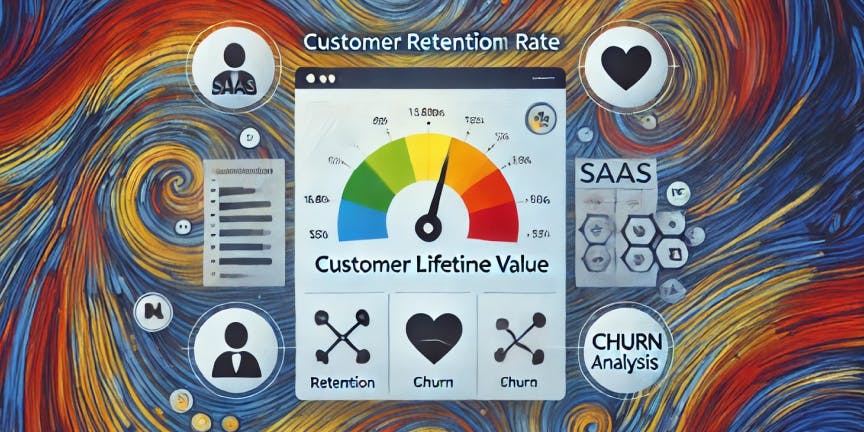Business growth isn't just about customer acquisition—it thrives on customer retention. Retaining customers is a cost-effective and loyalty-building strategy that turns satisfied customers into long-term brand advocates.
However, the challenge here is that tracking customer retention is necessary to determine whether your product meets customer needs and creates real value.
That's where Customer Retention Rate (CRR) comes into play.
This critical metric reveals how well you're holding onto your existing customers and highlights opportunities for scaling your revenue growth and long-term success.
In this guide, we will cover the fundamentals of Customer Retention Rate, why it matters, how to calculate it, and actionable tips to improve retention rate and scale your business.
What is the Customer Retention Rate?
Customer retention rate (CRR) quantifies the percentage of active customers who continue to engage with your business over a set period. This valuable metric acts as a barometer for customer loyalty, revealing how effectively your product meets existing and loyal customers' needs and encourages them to repeat purchases over exploring your competitors.
The high retention rate indicates your SaaS business has a steady income source regardless of whether you are acquiring new customers. It shows your ability to provide meaningful value that builds trust and long-lasting customer relationships.
Why is Tracking Customer Retention Important for SaaS Businesses?
Customer retention rate is vital to determine your business's scalability and profitability. It helps you understand how effectively your business retains existing customers and prevents them from churning. Here are other reasons why calculating and tracking the customer retention rate is important for a SaaS business:
1. Assessing product effectiveness
Measuring customer retention rates helps you determine the effectiveness of your product. A high retention rate indicates that your product resonates well with customer needs. On the other hand, a low retention rate signals potential issues, prompting a need to re-evaluate your marketing and retention strategies.
2. Strategic financial planning
High customer retention translates to consistent revenue through repeat purchases from existing customers, reducing dependency on new customer acquisition. Thus, it enables you to predict future earnings and plan your investment wisely.
3. Lower customer acquisition costs
For SaaS businesses, retaining customers is more cost-effective than acquiring new ones. While acquisition includes marketing and sales expenses, customer retention focuses on nurturing existing relationships.
Calculating CRR can strategically allocate resources to strengthen customer loyalty, reduce overall acquisition costs, and create a consistent, sustainable revenue stream.
4. Expand your market reach through advocacy
A high customer retention rate highlights loyalty and customer satisfaction. Loyal customers, whose needs are consistently met, are more likely to become brand advocates and recognise the value of your products or services.
Once your business prioritizes customer satisfaction, you can create stronger relationships that encourage these customers to recommend your offerings to friends and colleagues.
How to Calculate Your Customer Retention Rate?
Customer retention begins when active customers engage with your business, such as subscribing to newsletters, renewing their products, or using services regularly. This ongoing relationship continues as long as customers remain engaged and feel satisfied.
Tracking retention rates allows SaaS companies to measure how effectively they maintain these relationships over time. To calculate your customer retention rate, follow these simple steps:
Steps to Calculate Your Customer Retention Rate:
1. Identify the time frame: Define the specific period to measure CRR, such as monthly, quarterly, or annually.
2. Determine key variables:
- E = Number of customers at the end of the period
- N = Number of new customers acquired during the period
- S = Number of customers at the beginning of the period
3. Apply the CRR formula:

Example:
If you had 1,000 customers at the beginning of the month, acquired 100 new customers, and ended with 950 customers, the CRR would be:
CRR = ( 950 -100)/1000 X 100 = 85%
An 85% retention rate indicates that most customers continued their relationship with your business during the period.
What is a good customer retention rate?
While it's a common aspiration for SaaS businesses to reach a 100% customer retention rate, this goal could be more realistic. A good customer retention rate depends on the SaaS product and its effectiveness in meeting customers' needs and consistently providing them with the desired solution.
The customer retention rate for early-stage companies and startups could be much higher, as only a few companies in the starting stages experience a solid product-market fit.
For most businesses in the SaaS industry, the customer retention rate stands at 90%, according to data from ChartMogual. A good customer retention rate depends on your ARPA ( average revenue per account). With an ARPA of less than $25/month, it is at 75%. As you move upmarket, customer retention increases. With an ARPA of $1k/month, it can go above 90%.
Customer Retention Rate vs. Customer Churn Rate: Key Differences
The Customer Retention Rate and Churn Rate are closely connected—they're essentially two sides of the same coin. But they are different based on various aspects:
Metric | Customer Retention Rate (CRR) | Customer Churn Rate |
|---|---|---|
Definition | It measures the percentage of customers your business retains over a specific period. | It measures the percentage of customers who stop using your products or services within that same timeframe. |
Focus | CRR centers on loyalty and satisfaction, highlighting your ability to maintain relationships over time. | The churn rate reveals the impact of customer loss, which is essential for keeping your business financially healthy and sustainable. |
Formula | (Customers at the end of Period - New customer acquired during that set period) / Customers at the start of the set period * 100 | (Customers lost in the given period / Customers at the stand of the given period) * 100 |
Impact | A high retention rate indicates predictable future earnings, driving growth opportunities and stable relationships with returning customers. | High churn signals potential revenue loss, slowing sustainable revenue growth and indicating customer dissatisfaction. |
Insights for business | It shows how effectively your product/service meets customer needs and turns them into brand advocates. | It highlights the risk of losing customers and potential areas of improvement, such as converting free trials to paid plans. |
6 Effective Tips to Improve Customer Retention Rate
Since the customer retention rate directly connects to the churn rate, you should focus on minimizing churn while enhancing customer satisfaction and loyalty to fuel customer retention growth.
Here are effective strategies to increase your SaaS business's customer retention rate and reduce customer churn:
1. Target the 'RIGHT' customer
To maximize your customer retention rate, focus on target prospects who are genuinely interested and understand the value of your product. You can also focus on customers who share the same traits with your Ideal customer profiles(ICPs).
For instance, if you run a SaaS platform offering project management tools designed for small teams. Your ICPs are small businesses with 5-20 employees in the tech industry. Instead of targeting all small businesses, focus your marketing efforts on companies similar in size to your most successful clients.
This way, you can attract target prospects who will likely appreciate your product and its features. It will improve your retention and minimize the risk of churn.
2. Create an 'AHA' moment for customers
The 'AHA' moment is when they realise the actual value of your SaaS product or service. It answers their question, 'What's good in it for me?'
From the moment someone signs up, it's all about quickly and seamlessly guiding them to that "Aha!" moment.
To reach the Aha moment, improve your onboarding process by sharing educational content so that users can quickly understand your product and its features. If your product is complicated to understand, provide them with free training courses.
For example, HubSpot offers free training courses that guide customers to that moment of realization when they fully understand how to use its tools and services. These resources allow customers to utilize those products effectively for their needs and get the most out of the platform.

3. Offer adequate support for customer satisfaction
Excellent customer support can transform potential customers into loyal, satisfied ones. While customers may overlook minor product issues, they are unlikely to tolerate poor customer service, which can quickly drive them away. Ensuring customers can easily reach you when they encounter problems or need assistance is essential for maintaining positive relationships.
Integrating 24/7 live chat support can provide immediate solutions to their queries, making them feel valued and supported. Additionally, having a dedicated customer success team can offer personalized guidance, helping customers overcome challenges and get the most out of your product.
Implementing these customer support strategies will make customers feel valued and appreciated, as their experience is prioritized, leading to long-term relationships and improved customer retention.
4. Gather feedback from existing customers
Customer feedback offers insights into the real value your product delivers. Conducting surveys helps you understand why customers churn, enabling you to understand the issues and proactively resolve them.
Use occasional surveys—like in newsletters or after key milestones—to gather meaningful feedback and customer data. Avoid frequent requests and focus on critical customer journey stages, where customers will most likely provide constructive input. This approach helps you retain customers and reduce churn.
5. Utilize social media channels
Social media platforms are great ways to engage and deepen customer relationships with your existing audience and effectively retain customers. These channels directly allow you to listen to your customers, address their concerns, and create a more personal connection.
Using effective social media plans, such as strategic hashtags or setting up dedicated customer service accounts makes your business easily accessible on the platforms your target audience uses daily. Pairing this visibility with fast responses and meaningful solutions naturally leads to higher customer retention.
Check how Zendesk creates engagement by promoting exciting news to its target audience and establishing authority in the SaaS industry. The post also includes # hashtags like #ZendeskRelate strategically and attract an audience that wants to participate in their event.

6. Create a customer loyalty program
Customer retention relies on customer satisfaction and loyalty to your product. Loyalty programs are proven ways to keep customers loyal to your business.
When you think of customer loyalty programs, large businesses with rewards cards might come to mind. If you're a small SaaS company or startup, you can create newsletters and deliver them with discounts and offers to your loyal customers.
With this incentive, customers might buy additional features or renew their subscriptions. This approach increases the number of repeat customers, increasing customer retention.
If you're looking for more strategies to boost your retention, check out our comprehensive customer retention strategy guide for actionable tips.
Other Key SaaS Retention Metrics to Track
To build a loyal base and repeat purchases, you will need more than just basic metrics to cut it. You must dig deeper into other customer retention metrics to understand what's happening and why. Here are key retention metrics for SaaS that can accelerate your business growth.
1. Customer Lifetime Value (CLV)
Customer lifetime value is key to understanding customer relationships with your product or business. It allows you to measure how long your customers stay with your company. The longer they stay with your business, the higher the customer's lifetime value.
Formula:

This critical metric helps you identify whether your company needs to focus on acquiring new customers through a targeted customer growth plan or refine your strategies to improve retention of existing ones.
2. Net Promoter Score (NPS)
NPS measures customer loyalty by assessing how likely customers are to recommend your product to others. It's an indicator of satisfaction and long-term brand affinity.
Formula:

Promoters score 9-10, Passives score 7-8, and Detractors score 0-6.
A high NPS suggests strong customer loyalty and satisfaction, often leading to higher retention rates. Tracking NPS over time can help identify if customers feel more or less committed to your brand, allowing you to act before dissatisfaction escalates to churn.
3. Repeat Purchase Rate (RPR)
RPR is the percentage of customers who make more than one purchase within a given timeframe. It reflects customer loyalty and satisfaction, as repeat purchases indicate trust in the brand.
Formula:

Tracking RPR helps determine whether your customers remain satisfied and engaged enough to make repeat purchases. It clearly shows your retention strategies' effectiveness in building loyalty and sustaining engagement.
Boost Your Retention Rate to Drive Business Growth
Achieving a zero churn rate is practically impossible for most SaaS businesses, as some factors—such as external market conditions or unforeseen customer behaviour—are beyond their control. However, tracking their customer retention rate (CRR) gives them the tools to focus on the areas within their control.
To build a loyal customer base and reduce churn, focus on enhancing the customer journey, such as improving customer service, optimizing onboarding processes, and implementing loyalty programs. These actionable steps impact customer satisfaction, making customer retention easier and turning happy customers into lifelong advocates.
Struggling to boost retention? At Labsmedia, our SaaS marketing experts use key metrics and actionable SaaS KPIs to analyze your performance and create strategies that drive sustainable growth. Let's turn your metrics into results!
Transform Retention into Revenue
Develop a customer retention strategy with Labsmedia and watch your revenue grow.
FAQs
What kind of tools can I use to measure customer retention rate?
You can use tools like Google Analytics and HubSpot to monitor retention, customer engagement, user behaviour, and churn rates over specific periods.
Do investors care about the retention rate?
Yes, absolutely! Investors use CRR as a critical metric for SaaS businesses to predict revenue growth potential and scalability.
What is the net retention rate for SaaS?
Net retention rate (NRR) for SaaS is the metric used to calculate revenue growth or loss from existing customers, accounting for upgrades, downgrades, and churn.
Are there times when a low retention rate is OK?
A low retention rate may be acceptable for startups and early-stage companies refining their product-market fit. It is also acceptable for businesses with seasonal customers or experimental products if churn doesn't significantly impact long-term growth and profitability.



